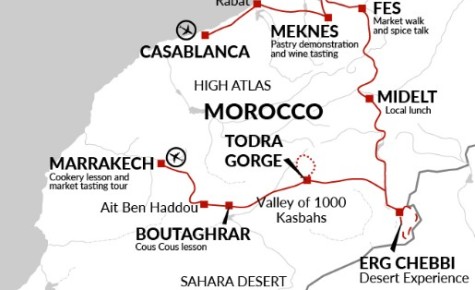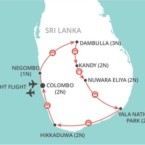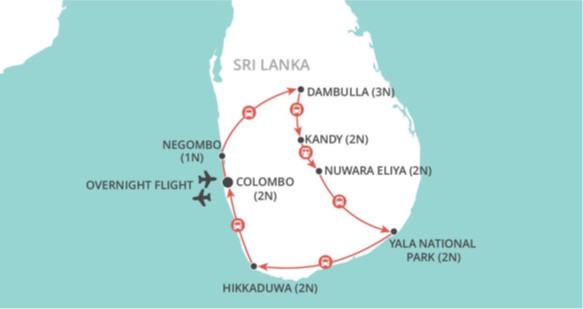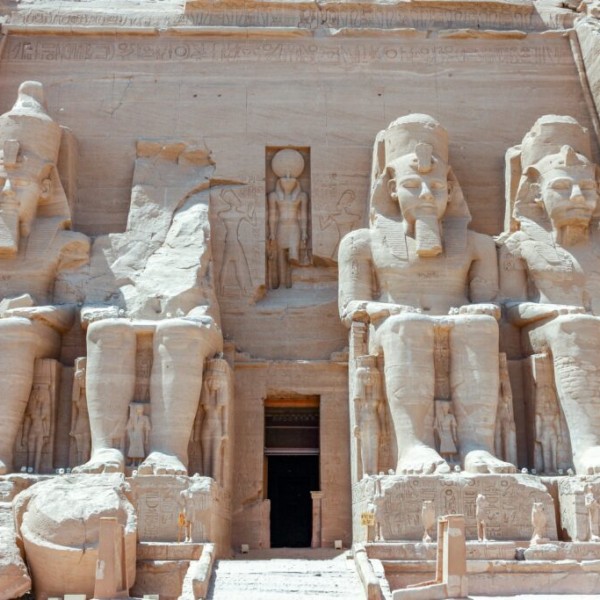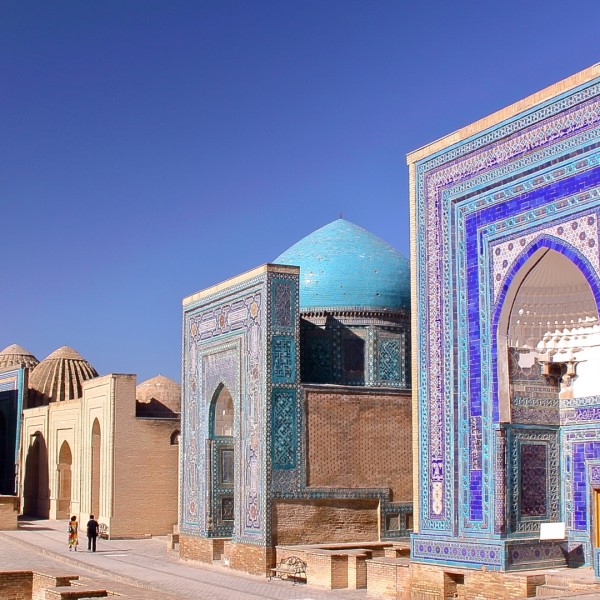Why book this trip?
Explore Morocco’s diverse flavours, aromas and colourful souks on this North African culinary adventure. Take in the four Imperial cities, the beautiful scenery of the Atlas Mountains and enjoy a night under the stars in a luxury camp in the Sahara, ending in Marrakesh’s vibrant night market.
- Imperial cities – Explore the aromatic souks and exhilarating atmosphere of Morocco’s cities
- Marrakech – Tagine cookery lesson and food sampling tour of the night market
- Berber cuisine – Try street food snacks and share traditional meals in local homes
Itinerary
- DAY 1 – Join trip in Casablanca
-
Arrive in Casablanca on the Atlantic coast where French colonial building blend with traditional Moroccan architecture. Casablanca has an atmosphere of prosperity and is where young Moroccans come to begin their careers.
For those arriving on time our Leader plans to meet you in the hotel reception at 7pm for the welcome meeting and then go out for a welcome dinner in a local seafood restaurant. If you decide to arrive after 7pm you will miss the included meal but your Leader will inform you of any essential information as soon as you catch up.
If you would like to receive a complimentary airport transfer today, you’ll need to arrive into Casablanca Mohammed V International Airport (CMN), which is around 45 minutes from the hotel depending on traffic. If your flight arrives earlier in the day, perhaps you might choose to visit Marche Central to get a feel for local life and to taste fresh seafood at one of the street food stalls or stroll to Place Mohamed V, Casablanca’s central plaza.
- DAY 2 – Guided tour of Rabat and continue to the imperial city of Meknes for wine tasting
-
This morning we travel along the coast heading north for about one and a half hours, towards the country’s capital city, Rabat.
Rabat was established as the capital of their protectorate by the French in 1912 and since independence has served as the capital of a modern Morocco. Rabat’s history stretches back as far as 8BC, when settlers arrived in what is now the Chellah area, a district that went on to become a prosperous Roman town, before being transformed by the Merinids into a cemetery. On arrival we will have an opportunity to explore something of the city’s historic heart, with a guided walking tour of the area around the Hassan Tower and the Mausoleum of Mohammed V, before wandering through the engaging Kasbah des Oudaias, originally a fortified town that is now infused with a distinctly Andalusian flavour. Here we will pause to sip mint tea in a traditional tea house. After our break we continue our journey to Meknes around a two hour drive, once the heart of the Moroccan Sultanate, lying amidst the landscapes of the Oued Boufekrane River valley. Here we have a short tour of Lahdim square with its vibrant food market where various types of olives are displayed.
The Phoenicians introduced viticulture to North Africa in in the Bronze Age and here, Meknes is the heart of Morocco’s growing wine scene. Popular grape varieties like Chardonnay and Cabernet Sauvignon are easily grown and we will visit one of the local vineyards for a tour and to sample its produce.
After checking into our hotel in Meknes we head out to a local restaurant for a pastry demonstration an included meal. There are many savoury and sweet dishes to try and your tour Leader will steer you in what to order based on your personal preferences.
- DAY 3 – Roman site of Volubilis, Moulay Driss and on to Fes for walking tour of the spice market
-
From Meknes we travel for 45 mins to the nearby ancient site of Volubilis – the capital of the Roman province of Mauritania Tingitana. A local guide will educate us about the well-preserved mosaics and the layout of provincial settlement before visiting an ancient oil press in the holy site of Moulay Driss. Here we will stroll through the fragrant market of fresh vegetables and marinated olives and stop for lunch in a local kebab restaurant. There are vegetarian options as well as meat kebabs.
This afternoon we’ll travel for a further two hours, to the country’s cultural capital, Fes. Probably the oldest of the imperial cities, its fascinating history is rich with wars, murders and political intrigue. It has played an important part in Moroccan trade, culture, religion and politics. The old and new towns are adjacent but totally separate entities. We’ll arrive in time to explore the many great food places that Fes has to offer. Your Tour Leader will guide you through the old medina and very narrow streets of the souks discovering the many ingredients used in traditional Moroccan dishes and explaining the spice blend that makes up the traditional seasoning Ras al hanout as well as visiting a communal oven. In Morocco, using a communal oven to bake your bread and other baked goods is the norm. The ovens are ran by workers whose primary job is to bake the edible goods of the community in the large oven, the majority of which is bread. You will have the opportunity to sample Bissara, a bean dip or sometimes served as a soup and sweet pancakes, two excellent street food snacks.
- DAY 4 – Drive over the Middle Atlas to Midelt, lunch with a Berber family
-
This morning to begin travelling south into the dramatic landscapes of the Middle Atlas, heading first towards Ifrane where we break our journey for mint tea with a nomad family. Then passing by near the small mountain village of Azrou, which in the Berber tongue translates as ‘the rock’. This is the land of the fiercely independent Berbers, the Lords of the Atlas, whose traditions and ways still hold sway up here in their mountain strongholds far away from the cities below. The Berbers present us with a unique view of a way of life lost to the rest of North Africa, where music and dance, even language and religion, are far removed from their Arab neighbours. We will stop for a lunch of grilled lamb (vegetarian alternative available) with a Berber family and learn more about Berber life in the mountains. After traversing the Atlas Cedar Forest, the journey continues along the high grazing lands to the small town of Midelt where we spend the night. The total driving time today is around three and a half hours.
- DAY 5 – Drive to Merzouga, and take 4WD vehicles into the desert for a night in a Berber Camp with traditional madfouna dinner
-
Heading into the mountains, the road we take today crosses the High Atlas over Tizi n Talghemet, translated as the Camel’s Pass and drops down through the Ziz gorge leading to the large oasis of Tafilalete, home to the largest date production in Morocco. It will take around four hours to get here and will of course stop to stretch our legs and see the date palms. The scenery changes dramatically and the journey ends in Merzouga at the foothills of Erg Chebbi dunes. A 4×4 vehicle takes us on the last leg of our journey today to a nomad style camp. The crew will prepare us a traditional Madfouna dinner, a stuffed bread baked in a fire pit in the desert sands. In the evening there will also be a demonstration of the local bread and mint tea preparation.
The tents accommodate up to two people each and bed, mattresses, blankets and pillows are provided. There are simple shower facilities available in each tent, however due to the nature of the accommodation, hot water and water pressure cannot be guaranteed.
- DAY 6 – Visit the old caravan centre of Rissani and on to Boutaghrar for a Cous cous lesson
-
We leave the desert and drive along the southern slopes of the hight Atlas. We make our first stop after about 45 minutes in the old caravan centre of Sijilmassa, known now as Rissani and visit its market for spices, traditional herbs and dates. Here we will learn about the origins of the spicy paste harissa. We then continue along the southern slopes of the Atlas to Tinerhir the entrance to Todra gorge, around two and a half hours later. We enter the narrow gorge with tiny villages and fertile fields along the river. The rock walls rise up to 300 metres and attract the rock climbers from all over the world. After a short visit, we continue to Dades and onto Boutaghrar in the rose valley. Late afternoon, we learn how to make a traditional couscous, perfectly cooked couscous topped with lamb, a variety of stewed vegetables and a flavorful broth. We will also meet a local family for a better insight of the Berber life style.
- DAY 7 – Ait Ben Haddou, High Atlas and Marrakech where we take a tasting tour on foot of the Djemma al Fna area
-
We continue our journey to Ouarzazate, a drive of about two hours, through the road of the thousand Kasbah’s. Before heading to the World Heritage site of Ait Ben Haddou, probably the most preserved Kasbah in the south and home of many famous movies. In the afternoon we will continue over the High Atlas Mountains through the spectacular Tizi n’Tichka Pass to Marrakech which will take about four hours. Once we have arrived to Marrakech and had a chance to check in at our hotel we will head to the famous Djemma al Fna square, home to a lively food market. We split in to small groups for a food tour of the small alleyways and back streets that make up some of the maze of streets around the main square. You will taste your way back to the main square and a final bowl of Moroccan stew, most likely followed by sweet pancakes or doughnuts which will see you off to bed content with a full belly!
- DAY 8 – Guided tour or Marrakech, cookery lesson
-
This morning a local guide will take us on a guided tour of the ‘red city’. Like many North African cities, Marrakech is divided into two distinct parts, the Gueliz (the modern French-built city) and the Medina (the Old City), a place where trade and barter amongst the colourful souks still renders its ancient heart a glittering cacophony of noise and colour. The city’s beating heart is the spectacular Djemaa el Fna, where you would have explored last night, a site not to be missed and a scene straight out of the pages of the Arabian Nights. Here we will find the streets and alleys alive with storytellers and musicians, jugglers and acrobats, snake charmers and clowns. Marrakech is a city like no other; with a staggering array of spectacular architecture and wonderful facades and not to be missed. We will visit the Koutoubia mosque and tower as well as the Bahia Palace. In your free time we suggest visiting the Saadian tombs, Ben Youssef medersa, the Dar Si Said Palace (now the Museum of Moroccan Art) and the Menara gardens.
Tonight we will have a cookery class to learn how to make a traditional Tagine. This will be our last supper, where we can reflect on all the new flavours we have tried this past week.
- DAY 9 – Trip ends in Marrakech
-
The trip ends after breakfast at our hotel in Marrakech.
There are no activities planned today, so you are free to depart from Marrakech at any time. If your flight is departing later in the day, luggage storage facilities are available at our hotel. If you would like to receive a complimentary airport transfer today, you need to depart from Marrakesh Menara Airport (RAK).
Depending on the schedule of your flights, you may have some additional time to wander in the souks of Marrakech or buy your last souvenirs before departure.
Inclusions
INCLUDED MEALS
Breakfast: 8
Lunch: 3
Dinner: 6
TRIP STAFF
Explore Tour Leader
TRANSPORT
Bus
ACCOMMODATION
1 nights comfortable auberge
1 nights premium camping
3 nights comfortable hotel
1 nights comfortable kasbah
2 nights premium riad
Images Courtesy of Explore Worldwide
EXW – XMR
Related experiences
Africa by Rail: Hosted Luxury Rovos Safari 2025 – Departs 28 August 2025
Tour Description Africa by Rail , a 10 day luxury Rovos Rail Safari, hosted by Rachel Williams – Founder and Adventure Guru from Viva Expeditions. Johannesburg to Victoria Falls, 28 August – 6 September 2025 Join us on an exclusive … Continue reading →
Norfolk Island & NSW Including Sydney Harbour Cruise – Departs 20 February 2025
Tour Departs: 20 February 2025 Tour Length: 16 Days Price From: Share Twin NZD $11,700.00pp | Supplement for Single Room NZD $2,750.00pp | Total Cost for Single Room NZD $14,450.00pp Where history meets paradise, experience the “Norfolk Wave.” Explore lush forests, pristine beaches, … Continue reading →
Japan in Autumn including Circle Japan Cruise – Departs 11 October 2024
Tour Departs: 11 October 2024 Tour Length: 27 Days We are venturing to Japan, Land of the Rising Sun, in time to enjoy the beginning of the autumn season. Autumn in Japan is about crimson leaves and perfect weather. As summer transitions … Continue reading →
CROSSROADS OF THE CAUCASUS – Escorted Tour – Departs 04 May 2025
Small group hosted journey • Guaranteed to go • Flights included Introduction Discover the exotic history and culture of the Caucasus on this hosted journey through Istanbul, Georgia, Armenia and Azerbaijan. Explore the ancient birthplace of viticulture and wine-making in … Continue reading →
Fabels of the Silk Road – 29 Days Escorted Tour – Departs 16 September 2025
Small group hosted journey • Guaranteed to go • Flights included Introduction Explore the cultural diversity and wonderful scenery of the ‘Five Stans’ of Central Asia. This varied landscape is home to traditional villages, ancient towns and glorious cities with … Continue reading →
Mexico Unveiled – 24 Days Escorted Tour – Departing 27 October 2025
Introduction Immerse yourself in the vibrant tapestry of Mexico on this unforgettable journey. From the turquoise waters of the Maya Riviera to the ancient wonders of Teotihuacan, we’ll journey through history, culture, and breathtaking natural beauty. Explore Maya ruins kissed … Continue reading →
Highlights of Sri Lanka for Solo Travellers – 17 days Fully Inclusive Group Tour – Departing 22 November 2024
Departing 22 November 2024 Highlights of Sri Lanka for Solo Travellers Negombo (1N) – Sigiriya (3N) – Kandy (2N) – Nuwara Eliya (2N) – Yala National Park (2N) – Galle (2N) – Colombo (2N) From stunning scenery to amazing architecture, … Continue reading →
Petra to the Pyramids – Departing 24 October 2024
TWIN from NZ$22,598 per person, SINGLE from NZ$26,905 From floating in the Dead Sea more than 400 metres below sea level, to walking through the Siq for your first glimpse of the soaring facade of the Treasury at Petra. From … Continue reading →
Escorted Tour to Vietnam & Cambodia with Anzac Memorials – Departing 01 April 2025
Historic Vietnam & Cambodia Exclusive Escorted Cruise & Land Tour – Auckland Return Tour Northern Vietnam, cruise the Mekong Delta, & visit ANZAC Memorials Escorted from NZ by Mark Nicholls of Mekong Princess Fly, Cruise & Land Tour Auckland – … Continue reading →
Silk Road Odyssey – 29 Days Escorted Tour – 2 departures, departing Christchurch 03 & 10 May 2025
29 Day Small Group Escorted Tour 03 – 31 May 2025 & 10 May-7 June 2025 Escorted by Discover Travel’s Peter Dunne & Lyndon Hadden Tour price from $19,495 per person twin/double share* $22,995 per person in a single room* … Continue reading →





